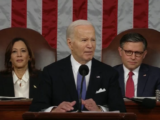
Senator Doug Jones greets a young supporter at a victory party in Birmingham, Sunday, Feb. 25, 2018: Glynn Wilson
Staff Report –
WASHINGTON, D.C. – U.S. Senator Doug Jones, the Democrat from Alabama, is calling for an investigation into student loan debt.
As the lead author of a letter to more than 100 key stakeholders nationwide to solicit feedback on how to help improve federal policies for student borrowers of color and make access to higher education more equitable, he was joined by Senators Elizabeth Warren of Massachusetts and Catherine Cortez-Masto of New Mexico to consult with experts in education policy and leaders in business, advocacy, academia, civil rights, consumer protection, and women’s issues.
“Students of color are more likely to borrow, borrow in greater amounts, and are less likely to be able to pay down their debt than their white peers – even if they graduate,” the senators wrote. “This disproportionate debt burden can cause significant financial distress and affect their ability to build their path to the middle class, a key goal of the federal financial aid investment.”
To discuss this issue and others impacting Historically Black Colleges and Universities, Senator Jones will host an HBCU Summit in Birmingham, Alabama on February 1, 2019. The Summit will provide a forum for students, educators, and administrators to exchange information and ideas to strengthen these vital educational institutions.
“African-American and Latino students still owe more than 100 percent of their loan balance after 12 years of college entry, even if they complete a degree. White students, meanwhile, owe anywhere between 47 to 70 percent of their loan balance depending on the credential they obtained,” the senators say. “Even among bachelor’s degree graduates, the African-American-white debt gap more than triples after graduation, due to differences in interest accrual, graduate school borrowing, and ongoing deeper issues related to labor market discrimination, racialized economic hardships, and familial wealth.
“These outcomes are staggering and unacceptable,” the letter concludes. “As members of Congress, we are committed to doing better for these students and ask for your assistance in defining specific proposals the federal government can take to address these disparities.”
The full text of the letter is available below and here.
January 3, 2019
Dear Stakeholders:
We write to you and other experts to solicit your thoughts and ideas on how to address racial disparities in student debt and the broader challenges faced by students of color in college and career training.
Students of color encounter significant obstacles in higher education. Degree attainment rates are dramatically lower among African-American, Latino, Pacific Islander, and American Indian/Alaska Native students than white students.[i] Additionally, students of color are more likely to borrow, borrow in greater amounts, and are less likely to be able to pay down their debt than their white peers—even if they graduate.[ii] This disproportionate debt burden can cause significant financial distress and affect their ability to build their path to the middle class, a key goal of the federal financial aid investment.
The consequences of student loan debt are particularly severe for those who do not complete and those who enroll in predatory, low-quality programs. For example, over half of Latino students do not complete college with a degree or certificate within six years despite entering college at higher rates than before and being the nation’s third fastest growing racial or ethnic group.[iii] This is a rate that is nearly 18 percentage points higher than white students.[iv] Likewise, nearly 60 percent of African-American students enrolled in college do not complete within six years – a rate that is 26 percentage points higher than white students. Roughly 7 in 10 African-American students who did not complete cite student debt as a primary reason for not finishing school, compared to less than half of white students.[v] Students who drop out with student debt are three times more likely to default on their student loans than students who graduate.[vi]
Completion is critical – but it still does not fully insulate all borrowers from bad loan outcomes. African-American and Latino students still owe more than 100 percent of their loan balance after 12 years of college entry, even if they complete a degree. White students, meanwhile, owe anywhere between 47 to 70 percent of their loan balance depending on the credential they obtained.[vii] Even among bachelor’s degree graduates, the African-American-white debt gap more than triples after graduation, due to differences in interest accrual, graduate school borrowing, and ongoing deeper issues related to labor market discrimination, racialized economic hardships, and familial wealth.[viii] In particular, African-American bachelor’s degree graduates default at five times the rate of white bachelor’s degree graduates, and are more likely to default than white college dropouts.[ix]
Finally, we note that not all students of color are even represented in the data available today. The Southeast Asian community is often not included in these trends and analyses of students of color because educational outcomes are often obscured in a larger “Asian” category. Asians are our nation’s fastest growing racial and ethnic group and are predicted to become the largest immigrant population in the country in 2055.[x] We would expect similar educational and debt trends because according to the Pew Research Center, 35 percent of Burmese Americans, 28.3 percent of Hmong Americans, 27.7 percent of Malaysian Americans, 19.1 percent of Cambodian Americans, 16.7 percent of Thai Americans, 14.9 percent of Laotian Americans, and 14.3 percent of Vietnamese Americans live below the poverty line compared to 15.1 percent nationally.[xi] Coupled with the fact that over half of Laotian, Cambodian, Hmong, and Vietnamese Americans have not attended or completed college, college cost and aversion to debt should also play a large role in educational attainment gaps for the Southeast Asian American community.[xii]
These outcomes are staggering and unacceptable. As members of Congress, we are committed to doing better for these students and ask for your assistance in defining specific proposals the federal government can take to address these disparities.
Given the complexity and high stakes of this issue, we ask you to share your expertise, insights, and proposals for protecting and empowering students of color, and student borrowers of color, and making higher education more equitable for all. We would appreciate if you shared your responses by February 15, 2019. Please contact rebecca_howard@jones.senate.gov.














Do we realize the vast majority of “socialist” countries, because the rich and corporations actually pay taxes, provide free education? In Finland, for example, residents are strongly encouraged to get a master’s degree FOR THE GOOD OF THE COUNTRY. Sadly, different mindset here. I received my free education under the old G.I. Bill as well as life long free medical services; if “we” can do this for veterans, why can’t the government do it for everyone FOR THE GOOD OF THE COUNTRY?